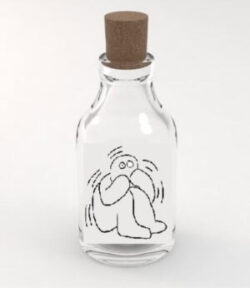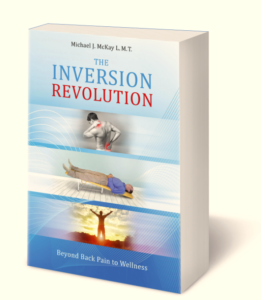Can Inversion Help with Depression?
by Dawn R. McKay M.S.-SLP, L.M.T.

It’s no surprise so many people are dealing with higher levels of stress these days.
We’re more isolated with so many adjusting to working from home and, when we do take a break, we’re bombarded by News that constantly updates us on the latest catastrophic conundrum.
This is especially a problem for people already dealing with higher degrees of Fearfulness and Depression.
We all have a basic understanding of how our Sympathetic Nervous System (SNS), which regulates our Fight or Flight Response, is repeatedly being over activated by the constant barrage of media sensationalism.
It’s as if someone has tripped the alarm and there appears to be no way to turn it off. We can feel trapped with no way out.

When this stress response becomes chronic, it can wreak havoc on our physical and mental health. It can appear as a low grade, yet constant anxiety followed by a withdrawal-like experience manifesting as depression.
It’s therefore imperative for our survival to implement stress relieving activities into our daily routines that help put us back into our Parasympathetic Nervous System (PNS), i.e. our state of being which supports relaxation, proper digestion, and mental and emotional wellbeing.
The Centers for Disease Control and Prevention (CDC) has addressed this with a useful list of steps to help manage this increase of stressfulness. [1]
We’d like to suggest adding gentle Low Angle Inversion to the list of things that may help lower stress levels and reduce anxiety and depression.
We know that inversion stimulates circulation of the cerebral spinal fluid and lymphatic fluid systems as well as brings more oxygen to the brain. These phenomena also occur during more intense exercise and correlate to an increased release of endorphins.
This natural release of endorphins also occurs through the practice of inversion and can be a great tool to help combat depression.
M.D. and author, Dr. Sara Gottfried, says, “Any time you put your feet above the level of your heart … you activate your parasympathetic nervous system, the rest-and-digest counterbalance to fight or flight … of the sympathetic nervous system.” [2]
Using inversion as a therapy is not new – in fact it’s very old.
Inversion therapy stems from the ancient art of yoga. Ann Brownstone, O.T.R., uses yoga to treat her patients who suffer from chronic, severe mood disorders and other ailments. She’s found that certain inverted yogic postures can have a tremendous impact relieving anxiety and depression.
She speculates that inversion stimulates the carotid sinus “to send messages to the medulla of the brain and cardiac centers that ultimately lower heart rate, respiration, and resting blood pressure.” [3] We think this is a reasonable hypothesis and invite researchers to test her theory.[4]
While this is great news for those she’s helped with anxiety and depression, not everyone can achieve these advanced yogic inverted postures, even with the help of an O.T.R. or trained Yoga teacher.
This is where a Gravity Pal® comes in.
Gentle inversion is easy to do on a Gravity Pal® Low Angle Inversion Table (also known by many as a “Slant Board”).
Furthermore, a broad spectrum of benefits have been reported – including reducing anxiety and depression – in sessions as brief as 1 to 3 minutes twice a day.
This tiny amount of time makes it very simple and easy to add inversion to a regular daily routine and thus experience the maximum cumulative results for body, mind and emotions.
Comedian and TV personality Rosie O’Donnell has been publicly outspoken about her struggle with depression. Along with yoga and medication, O’Donnell swears by inversion therapy as one of her greatest assets in combating her depression. “It really releases the serotonin,” she said, and joked while inverted, “And (it’s) good to have meetings like this with your staff.” [5]
Regularly experienced Low Angle Inversion sessions may help reduce depression and make it more manageable. It appears to be a side benefit of systematically and cumulatively reducing stress in the body and therefore in the mind.
In the past we’ve talked a lot about what regular Gravity Pal® sessions can do for physical health, and even mental clarity. [6] , [7]
It turns out inversion therapy can have additional mental health benefits besides reducing “Brain Fog” and improving clarity of thinking.
It appears that at-home inversion therapy can also be a tool to help combat the higher levels of stress, anxiety and depression so many of us are experiencing these days.
I invite everyone to try out a Gravity Pal® and see for themselves.
Please go to gravitypal.com/shop
-
https://www.cdc.gov/coronavirus/2019-ncov/daily-life-coping/managing-stress-anxiety.html ↑
-
Stress Makes You Fat & Adds Risk of Dementia, Depression, Infertility, http://www.healthylivingmagazine.us/Articles/574/ , accessed: August 12, 2020 ↑
-
Inversions for Anxiety and Depression, https://yogafordepression.com/inversions-for-anxiety-and-depression/ , accessed August 12, 2020 ↑
-
An Invitation to Researchers, https://www.gravitypal.com/researchers-invitation/ ↑
-
Rosie turns depression treatment on its head, https://www.today.com/popculture/rosie-turns-depression-treatment-its-head-wbna17541917 Accessed August 12, 2020 ↑
-
Developing a Self-Care Strategy for Back Pain, https://www.gravitypal.com/developing-self-care-strategy-back-pain/ ↑
-
Big Surprise!! Improved Mental Clarity from LOW Angle Inversion?, https://www.gravitypal.com/MentalClarity ↑







Very timely. Anything that increases blood to the brain would help. Also, depressed people sometimes don’t have enough energy to exercise so this is a good alternative.